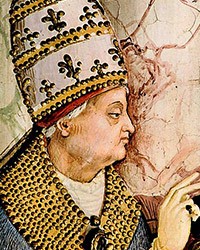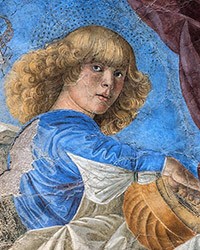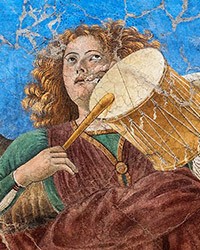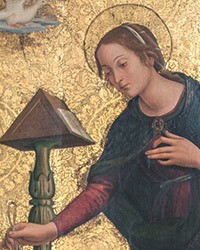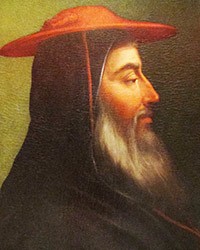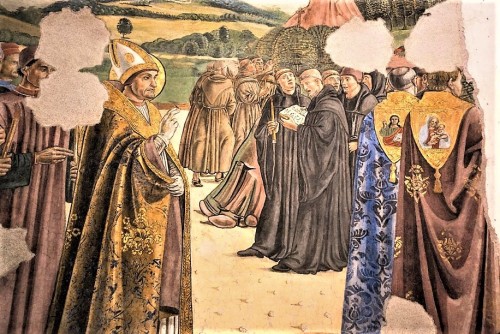
Antoniazzo Romano, frescoes in the Chapel of Cardinal Bessarion, Basilica of Santi XII Apostoli
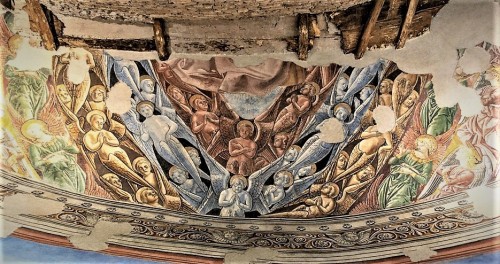
Antoniazzo Romano, frescoes in the Chapel of Cardinal Bessarion, Basilica of Santi XII Apostoli
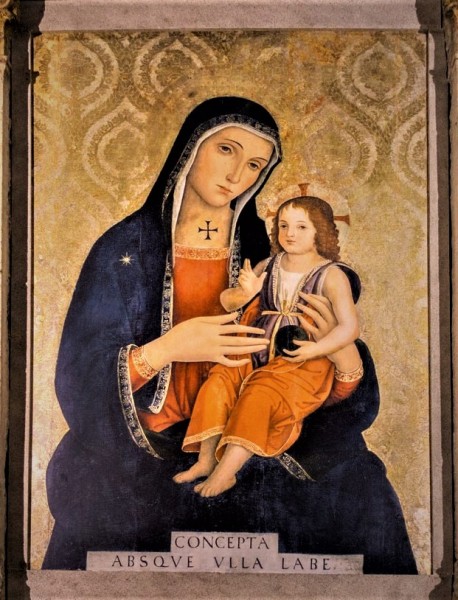
Madonna and Child, fresco after the painting by Antoniazzo Romano, Basilica of Santi XII Apostoli
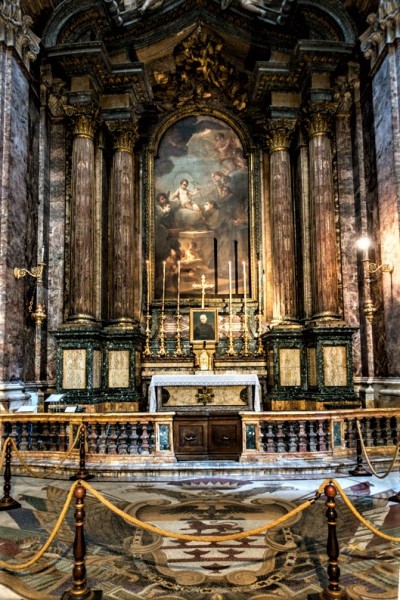
St. Anthony of Padua Chapel, Basilica of Santi XII Apostoli
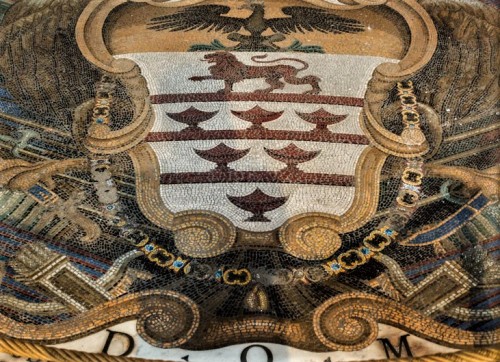
Coat of arms of the Odescalchi family - mosaic in front of the Chapel of St. Anthony of Padua, Basilica of Santi XII Apostoli
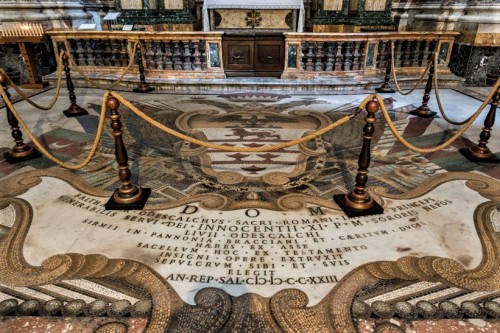
Mosaic commemorating Pope Innocent XI of the Odescalchi family, Chapel of St. Anthony of Padua, Basilica of Santi XII Apostoli
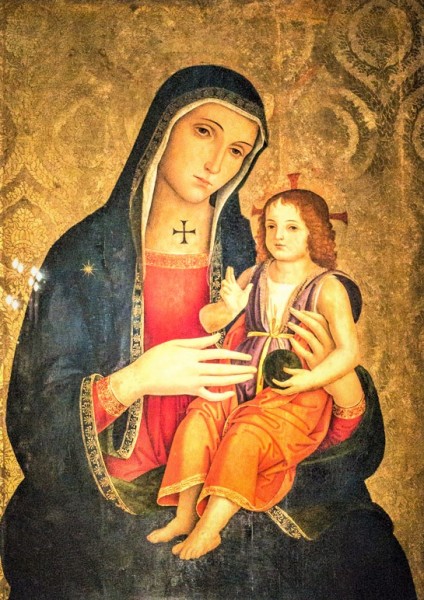
Antoniazzo Romano, Madonna and Child, Chapel of St. Bonaventure, Basilica of Santi XII Apostoli
Today in the Church of Santi Apostoli we can only see the apse of this exceptional structure, hidden behind an altar of another chapel, dedicated to Saint Anthony of Padua (the third chapel on the right). It can only be entered on selected days, however gaining access ensures that we are transported to the times when the church was a veritable pearl of the Renaissance, while the posthumous chapel of cardinal Bessarion, was one of the most beautifully decorated structures in all of the city. Cataclysms and subsequent modernizations of the church led to the destruction of its decorations. Fortunately, some were preserved, but in a greatly diminished form.
Today in the Church of Santi Apostoli we can only see the apse of this exceptional structure, hidden behind an altar of another chapel, dedicated to Saint Anthony of Padua (the third chapel on the right). It can only be entered on selected days, however gaining access ensures that we are transported to the times when the church was a veritable pearl of the Renaissance, while the posthumous chapel of cardinal Bessarion, was one of the most beautifully decorated structures in all of the city. Cataclysms and subsequent modernizations of the church led to the destruction of its decorations. Fortunately, some were preserved, but in a greatly diminished form.
The former chapel of Bessarion is located about eighty centimeters below the level of the present-day church. In order to access it, we must take the stairs down. There, thanks to the constructed bridges, we can come face to face with the fragments of the preserved frescoes. However, before we begin to describe them, we must spare a few words to tell the history of this strange place. At the behest of Pope Pius II, in recognition of the attempts to unify the Byzantine and Roman Churches, which ultimately failed, the chapel was gifted to a dignitary of the Greek Church – Bessarion. He had for many years resided in Rome, converted to Catholicism, and became the titular cardinal of the Church of Santi Apostoli (1439-1449). The chapel, which had previously been dedicated to Saint Eugenia, became his property in 1463. After its takeover, works began on its decorations, which lasted four years and in which the cardinal desired to manifest his devotion to St. John the Baptist and the Archangel Michael, but not only that.
Not much remains from the chapel itself and its decorations, but thanks to the Franciscan, Bonaventura Malvasia, who described this place in 1665, meaning prior to the construction of the aforementioned Chapel of St. Anthony, we know its main decorations. Let us start from the top. At the base of the apse, we can see a choir of angels, above which in the past there was a figure of the enthroned Jesus Christ (the fragment was destroyed, which only survived in the form of the coattails. He was most likely flanked by the figures of the Virgin Mary and John the Baptist (principal intercessors) as well as the Archangel Michael, St. Eugenia, and the donator himself – the kneeling cardinal Bessarion. This was in the past, a culminating point of the painting decorations of the chapel, referencing the traditional representations of Deesis in Orthodox churches. Christ was presented among the nine heavenly choirs in the work On the Celestial Hierarchy by Pseudo-Dionysius Areopagite – one of the main authorities in the field of angelology (VI century), who was valued by both Bessarion and by the Eastern Church. According to him, God created the world a cares for it, and he implements all his plans through the angels, who praise his glory. Angels can cooperate with God, and at the head of each host of angels, there is one who is the leader – and such was the Archangel Michael. According to this belief, man was created so that throughout his whole life he may learn, come to understand, and experience divinity. That is how the cardinal saw his life – as a constant practice of virtues, which would make him worthy of being raised to a divine level.

Below there are (rather well-preserved) two figural cycles, which directly reference the life and spiritual path of Bessarion. They are connected with the story of the aforementioned Archangel Michael, a figure who was very popular in the tradition of the Eastern Church. He held the title of Prince of the Celestial Armies, one who helps people in the spiritual combat against evil, and acts as an intercessor with God on their behalf, he is a flaming warrior, fighting for justice and law. A testimony to the position of the prince among other angels is the fact that, in Constantinople itself, from where Bessarion came, there were fifteen churches dedicated to him. In the Roman chapel, we can see him in the form of a bull who escaped from his herd and hid in the grotto on Gargano Mountain in Apulia. The men attempting to capture him are shooting at him, but their arrows return to them. According to the Golden Legend by Jacopo de Voragine, they call upon the bishop of the nearby city of Siponto, who recognizes the Archangel Michael and is told by him to create a sanctuary in this place. As a result, still, today pilgrims flock to the grotto to pay homage to the image of the Archangel Michael found in the underground sanctuary. The second scene (on the right) shows the ceremony of consecration of the sanctuary of Archangel Michael in the Norman Mont Saint-Michel. The rather well-preserved fresco shows the bishop (and later) Saint Aubert of Avranches, who at the beginning of the VIII century consecrated this sanctuary. The painting is a reference to the legend according to which, the Archangel Michael appeared to the saint, also asking him to erect a sanctuary. On the fresco, we can see monks (Franciscans and Basilians) singing hymns, as well as sacral and Church dignitaries. The two orders were the monks, with whom Bessarion shared a particularly strong connection and who represented both the Eastern and Western Churches. The principal figure is Aubert himself, dressed in rich liturgical robes. Behind him stand the supporter of Bessarion in his anti-Turkish crusade – dressed in a red coat, Francesco delle Rovere (the future Pope Sixtus IV) as well as his nephew Giuliano delle Rovere (the later Pope Julius II) – both with a candle in hand. It is assumed that referencing the important in France, St. Aubert was done to encourage the French King, Louis XI to join the anti-Turkish league in order to organize a crusade and retake Constantinople which was seized by the Turks in 1453. This undertaking was of the utmost importance to cardinal Bessarion until his death. The choice of the protagonist of the chapel decorations in the figure of the Archangel Michael, who was already shown as a supporter of the struggle against the Persians in the Book of Daniel, and whose cult through Gargano reached Western Europe, proves how important a patron this was for the cardinal, underlining his significance as a symbol of all Christians (Eastern and Western) struggling in the fight against evil and Muslims. Let us not forget that it was the angel whom Gregory I the Great was to see during a procession to stop the plague, thus turning the pagan Hadrian’s Mausoleum into the Castle of Saint Michael the Archangel.

The remaining paintings which decorated the original chapel were destroyed. We only know of them through Malvasia’s description. According to him, below were frescoes representing the story of the birth of St. John the Baptist, and still lower the images of the Four Evangelists, the four Fathers of the Western Church, and the four Fathers of the Eastern Church. Malvasia did not directly see these, but rather knew of them, since in 1545 due to a flood the decorations were damaged and were covered with a layer of lime, and subsequently with new paintings representing two saints – Eugenia and Clara. They flanked the middle fresco with a representation of Madonna and the Child. This is a copy of an icon that was originally located in the aedicule situated here. This part was destroyed, while the painting of Our Lady was moved to the nearby Chapel of St. Bonaventure (the first in the very same nave), where it can still be viewed today. The subtle face of Mary, the sadness seen upon it, and the melancholy fit in perfectly with her delicate, beautiful palms caressing the blond-haired child sitting on her forearm, who with a gesture of his hand blesses the onlookers.
Antoniazzo Romano was a well-known creator of images of Our Lady and we can assume that he completed the painting, although according to tradition it was considered to be the work of the apostle Luke himself, brought from Constantinople by cardinal Bessarion.
There are still arguments today regarding the authorship of the frescoes. The newest studies attribute them to Antoniazzo Romano and his workshop. However, some historians point to other authors who could have helped in creating the paintings. Perhaps they included Melozzo da Forlì and Lorenzo da Viterbo.
The Renaissance frescoes were covered in 1652 by the monumental Chapel of St. Anthony, designed by Carlo Rainaldi. It was funded by the Odescalchi family which is testified to by the grand mosaic on the floor (in front of the chapel) showing the family coat of arms and commemorating its most significant representative – Pope Innocent XI.
There would have probably been no trace left of Bessarion’s Chapel, had it not been for the archeological works conducted in 1959 in the Palazzo Colonna, neighboring the church, during which its remains were discovered. The chapel housed the funerary monument of the cardinal with an inscription, and this was all that was left. Today it can be seen in the cloister wall of the Franciscan convent found next to the church.
And that is all that is left from the Renaissance chapel – a magnificent example of a well-thought-out artistic concept of one of the most outstanding humanists of his times.


















